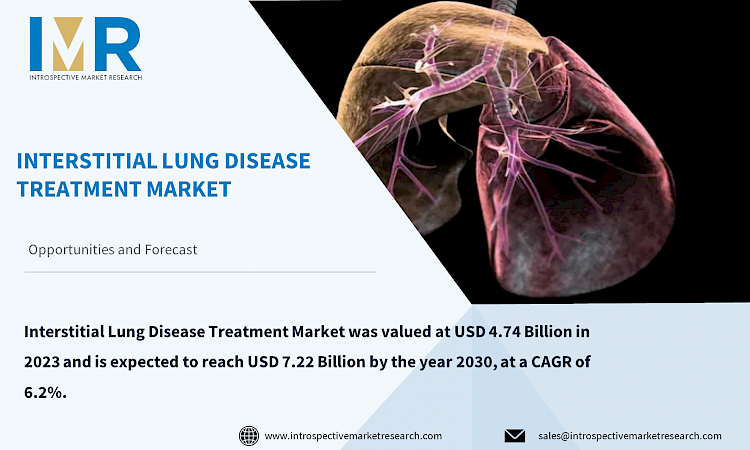
Global Interstitial Lung Disease Treatment Market was valued at USD 4.74 Billion in 2023 and is expected to reach USD 7.22 Billion by the year 2030, at a CAGR of 6.2%.
The human body's gas exchange is carried out by the two spongy organs known as the lungs. The rib cage surrounds and shields the lungs, which are situated on either side of the chest. The air that is inhaled passes through the bronchi, bronchioles, and windpipe before entering tiny air sacs known as alveoli. These alveoli carry out the crucial job of exchanging breathed oxygen for carbon dioxide, a waste product of metabolism, in the lungs. The interstitium, a thin layer of cells that supports the alveoli and contains blood arteries, lies between these alveoli. The phrase "interstitial lung disease" (ILD) refers to a broad category of illnesses that result in lung fibrosis, or scarring. Because of the lung rigidity brought on by the scarring, breathing becomes more difficult, which lowers blood oxygen levels. The majority of lung damage caused by ILDs is irreversible, and it worsens with time. Children of any age can be impacted by interstitial lung disease. Genetics, medical procedures like radiation or chemotherapy, or specific drugs can all raise the risk of or cause ILDs. The most typical signs and symptoms of interstitial lung disease include coughing up dust and having trouble breathing. The market for ILD treatments is expected to grow during the projected period as a result of the increased prevalence of ILDs brought on by air pollution. In genetic ILD, the disease is passed from parents to offspring, and the most common diseases are neurofibromatosis and Gaucher disease. The prevalence of autoimmune diseases and an increasing number of people who smoke are two major factors expected to drive the expansion of the interstitial lung disease treatment market during the forecast period. People are becoming more aware of the different treatments that can help manage other complications associated with ILD. People over the age of 50 are more prone to ILD than other age groups. Over the past decade, the number of elderly has increased significantly, hence the demand for ILD treatment will explode during the forecast period. The proliferation of interstitial lung disease treatments and increasing activities are expected to support market expansion during the forecast period in the market. Air pollution has caused concern in all countries of the world. Burning coal, tobacco, and other materials releases various harmful substances into the atmosphere, causing ILDs in people with weak immune systems. According to Scientific American, 4.5 percent of the world's population suffers from autoimmune diseases. As autoimmune patients are more prone to ILD, this is expected to create a profitable opportunity for market participants to discover new drugs that can treat both autoimmune diseases and ILD. In addition, the majority of the population suffering from ILD lives in developing regions. Manufacturers can target these regions to increase revenue and launch new products that meet the needs of patients in the region and make ILD treatment affordable. Supportive government policies and voluntary participation of candidates in new drug trials are important factors that create lucrative opportunities for market players.
Interstitial Lung Disease Treatment Market, Segmentation
The Interstitial Lung Disease Treatment market is segmented based on diagnosis type, disease, and region.
Depending on the diagnosis:
The CT scan segment is expected to account for the largest share of the ILD treatment market during the forecast period. CT scanners use a computer to combine X-ray images taken from different angles to produce a cross-sectional image of internal structures. A high-resolution CT (HRCT) scan can help assess the extent of lung damage caused by ILD. In addition, a CT scan can show the detailed distribution of fibrosis, which can help the healthcare provider narrow down the diagnosis and guide appropriate treatment. The growing popularity of HRCT among healthcare providers for detecting early signs of ILD is expected to support the growth of this segment during the forecast period.
Depending on the disease type:
It is anticipated that during the anticipated period, the sarcoidosis type of the disease will become more common. Granulomas, or inflamed tissue, occur in the lymph nodes and lungs as a result of the inflammatory disease sarcoidosis, which triggers the immune system to overreact. The Sarcoidosis Research Foundation estimates that 200,000 patients are identified with the disease in the US each year. Sarcoidosis can affect anyone at any age, however it is more common in those of African and Scandinavian ancestry.
Region:
North America is poised to lead the ILD treatment market due to the presence of key manufacturers and the significant prevalence of diseases such as IPF, which affects around 15-20 people per 100,000 worldwide. ILD affects 100,000 Americans, and 30,000 to 40,000 new cases are diagnosed each year. Europe is following suit, with air pollution and high smoking rates contributing to ILD growth, especially in countries such as Bulgaria, Greece, and Germany, where smoking rates are particularly high. Asia Pacific is expected to grow the ILD treatment market the fastest due to the widespread use of asbestos despite bans in more than 50 countries. Asbestos-related diseases account for approximately 107,000 deaths annually in India alone, fueling market growth.
Some of The Leading/Active Market Players Are-
- Merck Sharp & Dohme Corp. (US)
- Gilead Sciences Inc (US)
- Bristol-Myers Squibb Company (US)
- FibroGen Inc (US)
- Liminal Biosciences (Canada)
- Boehringer Ingelheim International GmbH (Germany)
- F. Hoffman - La Roche Ltd (Switzerland)
- Galecto Inc (Denmark)
- J.B. Chemicals & Pharmaceutical (India)
- Cipla Ltd (India)
- Glenmark Pharma (India) and other Active players.
Key Industry Developments
- In February 2022, Boehringer Ingelheim's BI 1015550, a PDE4B inhibitor, was granted breakthrough therapy designation by the FDA for idiopathic pulmonary fibrosis (IPF). It targets fibrosis and inflammation. FibroGen's pamrevlumab, which blocks CTGF, also received a breakthrough treatment for IPF, which can lead to Duchenne muscular dystrophy and pancreatic cancer. Roche's Esbriet Receives Breakthrough Designation for Unclassified Interstitial Lung Disease (uILD) Based on Phase II Study Data.
- In March 2021, biotech company F. Hoffmann-La Roche Ltd announced that the US Food and Drug Administration (FDA) approved the subcutaneous injection of Actemra/RoActemra (tocilizumab) to slow the decline of lung function in adult patients with systemic disease. sclerosing interstitial lung disease (SSc-ILD), a debilitating condition with limited treatment options. Actemra/RoActemra is the first biologic therapy approved by the US FDA for the treatment of this disease.
Key Findings of the Study
- The diagnostic CT segment is expected to dominate, helping to assess lung lesions and guide treatment decisions with high-resolution imaging.
- Sarcoidosis is thought to be the main type of ILD, particularly affecting African and Scandinavian populations.
- North America is leading the way in. ILD. treatment market. which has a significant impact of diseases such as IPF, while Europe follows due to air pollution and smoking.
- Asia Pacific is the fastest growing market, driven by asbestos-related diseases, despite bans imposed by many countries, especially India.




